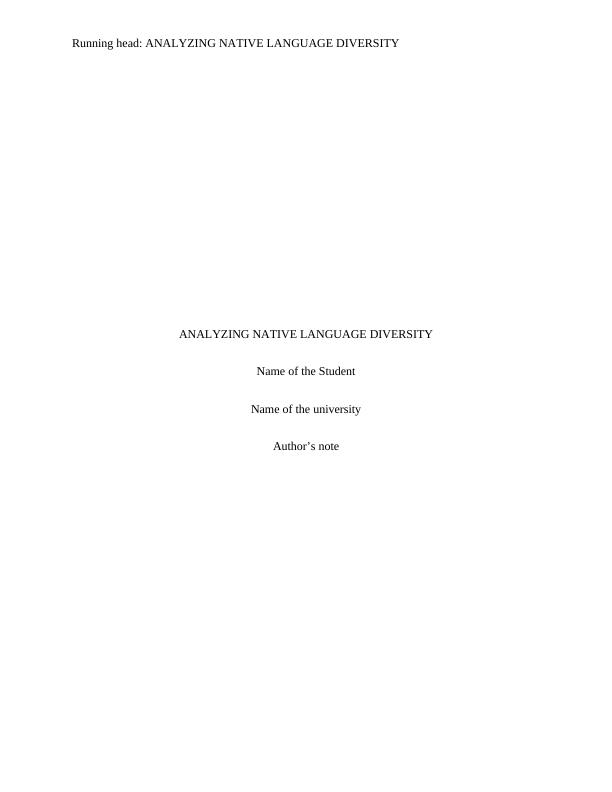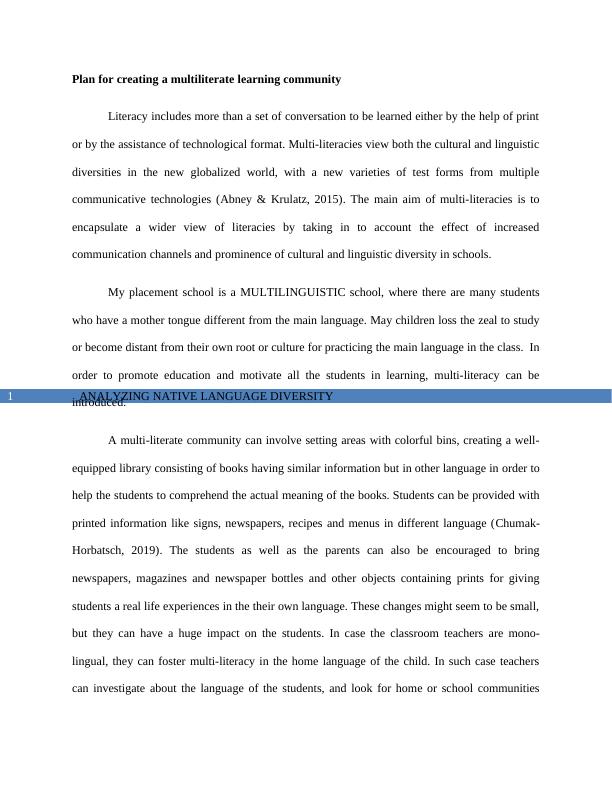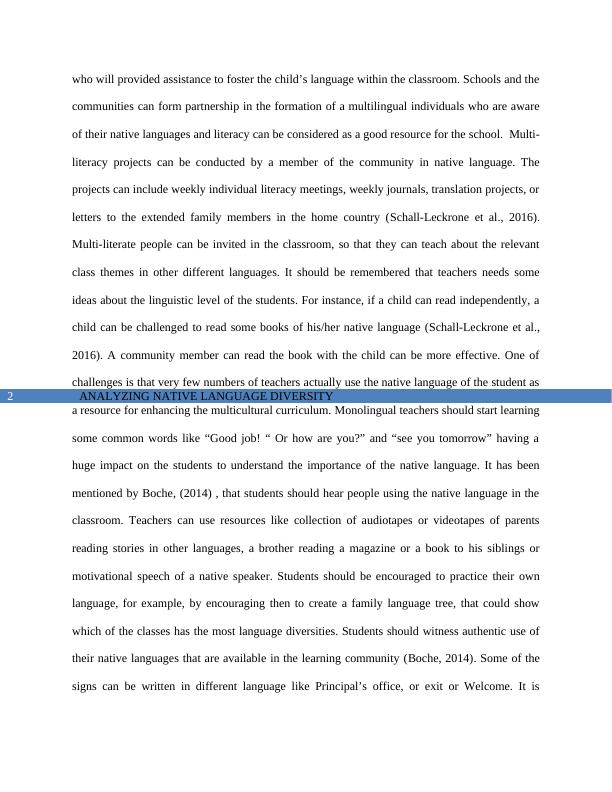Association of Mexican American Educators Journal
Added on 2022-09-01
8 Pages1760 Words18 Views
Running head: ANALYZING NATIVE LANGUAGE DIVERSITY
ANALYZING NATIVE LANGUAGE DIVERSITY
Name of the Student
Name of the university
Author’s note
ANALYZING NATIVE LANGUAGE DIVERSITY
Name of the Student
Name of the university
Author’s note

ANALYZING NATIVE LANGUAGE DIVERSITY1
Plan for creating a multiliterate learning community
Literacy includes more than a set of conversation to be learned either by the help of print
or by the assistance of technological format. Multi-literacies view both the cultural and linguistic
diversities in the new globalized world, with a new varieties of test forms from multiple
communicative technologies (Abney & Krulatz, 2015). The main aim of multi-literacies is to
encapsulate a wider view of literacies by taking in to account the effect of increased
communication channels and prominence of cultural and linguistic diversity in schools.
My placement school is a MULTILINGUISTIC school, where there are many students
who have a mother tongue different from the main language. May children loss the zeal to study
or become distant from their own root or culture for practicing the main language in the class. In
order to promote education and motivate all the students in learning, multi-literacy can be
introduced.
A multi-literate community can involve setting areas with colorful bins, creating a well-
equipped library consisting of books having similar information but in other language in order to
help the students to comprehend the actual meaning of the books. Students can be provided with
printed information like signs, newspapers, recipes and menus in different language (Chumak-
Horbatsch, 2019). The students as well as the parents can also be encouraged to bring
newspapers, magazines and newspaper bottles and other objects containing prints for giving
students a real life experiences in the their own language. These changes might seem to be small,
but they can have a huge impact on the students. In case the classroom teachers are mono-
lingual, they can foster multi-literacy in the home language of the child. In such case teachers
can investigate about the language of the students, and look for home or school communities
Plan for creating a multiliterate learning community
Literacy includes more than a set of conversation to be learned either by the help of print
or by the assistance of technological format. Multi-literacies view both the cultural and linguistic
diversities in the new globalized world, with a new varieties of test forms from multiple
communicative technologies (Abney & Krulatz, 2015). The main aim of multi-literacies is to
encapsulate a wider view of literacies by taking in to account the effect of increased
communication channels and prominence of cultural and linguistic diversity in schools.
My placement school is a MULTILINGUISTIC school, where there are many students
who have a mother tongue different from the main language. May children loss the zeal to study
or become distant from their own root or culture for practicing the main language in the class. In
order to promote education and motivate all the students in learning, multi-literacy can be
introduced.
A multi-literate community can involve setting areas with colorful bins, creating a well-
equipped library consisting of books having similar information but in other language in order to
help the students to comprehend the actual meaning of the books. Students can be provided with
printed information like signs, newspapers, recipes and menus in different language (Chumak-
Horbatsch, 2019). The students as well as the parents can also be encouraged to bring
newspapers, magazines and newspaper bottles and other objects containing prints for giving
students a real life experiences in the their own language. These changes might seem to be small,
but they can have a huge impact on the students. In case the classroom teachers are mono-
lingual, they can foster multi-literacy in the home language of the child. In such case teachers
can investigate about the language of the students, and look for home or school communities

ANALYZING NATIVE LANGUAGE DIVERSITY2
who will provided assistance to foster the child’s language within the classroom. Schools and the
communities can form partnership in the formation of a multilingual individuals who are aware
of their native languages and literacy can be considered as a good resource for the school. Multi-
literacy projects can be conducted by a member of the community in native language. The
projects can include weekly individual literacy meetings, weekly journals, translation projects, or
letters to the extended family members in the home country (Schall-Leckrone et al., 2016).
Multi-literate people can be invited in the classroom, so that they can teach about the relevant
class themes in other different languages. It should be remembered that teachers needs some
ideas about the linguistic level of the students. For instance, if a child can read independently, a
child can be challenged to read some books of his/her native language (Schall-Leckrone et al.,
2016). A community member can read the book with the child can be more effective. One of
challenges is that very few numbers of teachers actually use the native language of the student as
a resource for enhancing the multicultural curriculum. Monolingual teachers should start learning
some common words like “Good job! “ Or how are you?” and “see you tomorrow” having a
huge impact on the students to understand the importance of the native language. It has been
mentioned by Boche, (2014) , that students should hear people using the native language in the
classroom. Teachers can use resources like collection of audiotapes or videotapes of parents
reading stories in other languages, a brother reading a magazine or a book to his siblings or
motivational speech of a native speaker. Students should be encouraged to practice their own
language, for example, by encouraging then to create a family language tree, that could show
which of the classes has the most language diversities. Students should witness authentic use of
their native languages that are available in the learning community (Boche, 2014). Some of the
signs can be written in different language like Principal’s office, or exit or Welcome. It is
who will provided assistance to foster the child’s language within the classroom. Schools and the
communities can form partnership in the formation of a multilingual individuals who are aware
of their native languages and literacy can be considered as a good resource for the school. Multi-
literacy projects can be conducted by a member of the community in native language. The
projects can include weekly individual literacy meetings, weekly journals, translation projects, or
letters to the extended family members in the home country (Schall-Leckrone et al., 2016).
Multi-literate people can be invited in the classroom, so that they can teach about the relevant
class themes in other different languages. It should be remembered that teachers needs some
ideas about the linguistic level of the students. For instance, if a child can read independently, a
child can be challenged to read some books of his/her native language (Schall-Leckrone et al.,
2016). A community member can read the book with the child can be more effective. One of
challenges is that very few numbers of teachers actually use the native language of the student as
a resource for enhancing the multicultural curriculum. Monolingual teachers should start learning
some common words like “Good job! “ Or how are you?” and “see you tomorrow” having a
huge impact on the students to understand the importance of the native language. It has been
mentioned by Boche, (2014) , that students should hear people using the native language in the
classroom. Teachers can use resources like collection of audiotapes or videotapes of parents
reading stories in other languages, a brother reading a magazine or a book to his siblings or
motivational speech of a native speaker. Students should be encouraged to practice their own
language, for example, by encouraging then to create a family language tree, that could show
which of the classes has the most language diversities. Students should witness authentic use of
their native languages that are available in the learning community (Boche, 2014). Some of the
signs can be written in different language like Principal’s office, or exit or Welcome. It is

End of preview
Want to access all the pages? Upload your documents or become a member.
Related Documents
Multi-cultural environment also provides social justicelg...
|8
|1870
|20
Contemporary Approaches for Teaching Communication and Literacy in Early Childhood Educationlg...
|10
|2376
|50
Teaching Communication, Language and Literacy to Multilingual Learners in Early Childhood Settingslg...
|10
|2745
|51
Enhancing Literacy and Language Development in Preschool Childrenlg...
|9
|2550
|239
Language and Literacy for Early Childhood PDFlg...
|13
|3651
|520
Child Education Report 2022lg...
|11
|3378
|39
